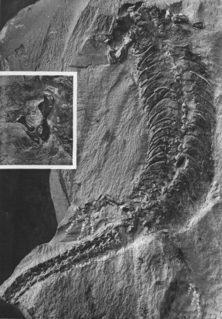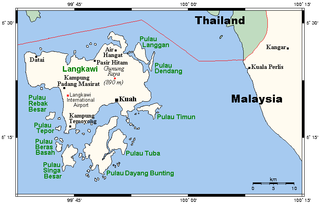
Alexandre Brongniart was a French chemist, mineralogist, geologist, paleontologist, and zoologist, who collaborated with Georges Cuvier on a study of the geology of the region around Paris. Observing fossil content as well as lithology in sequences, he classified Tertiary formations and was responsible for defining 19th century geological studies as a subject of science by assembling observations and classifications.

Rhabdodon is a genus of ornithopod dinosaur that lived in Europe approximately 70-66 million years ago in the Late Cretaceous. It is similar in build to a very robust "hypsilophodont", though all modern phylogenetic analyses find this to be an unnatural grouping, and Rhabdodon to be a basal member of Iguanodontia.
Paleontology or palaeontology is the study of prehistoric life forms on Earth through the examination of plant and animal fossils. This includes the study of body fossils, tracks (ichnites), burrows, cast-off parts, fossilised feces (coprolites), palynomorphs and chemical residues. Because humans have encountered fossils for millennia, paleontology has a long history both before and after becoming formalized as a science. This article records significant discoveries and events related to paleontology that occurred or were published in the year 1990.

The Calcaire de Caen or Calcaires de Caen Formation; French for Caen Limestone, is a geological formation in France. It dates back to the mid-Bathonian of the Jurassic. It was often quarried for building work and is referred to as Caen Stone.
The Calcaire à Spatangues is a geological formation in the Paris basin of northern central France whose strata date back to the Early Cretaceous. Dinosaur remains are among the fossils that have been recovered from the formation.

Sauravus is an extinct genus of nectridean lepospondyl within the family Scincosauridae.

Ptychoceratodus is an extinct genus of prehistoric sarcopterygians or lobe-finned fish originally named as a species of Ceratodus in 1837. It was a lungfish from the Mesozoic era (Triassic-Cretaceous), and the only members of the family Ptychoceratodontidae. One species, P. oldhami, was named in 2018 based on remains from the Carnian-aged Tiki Formation (India). The first named species, which is also the type species, is P. phillipsi, which was named in 1837 by Louis Agassiz as a species of Ceratodus and moved to a separate genus in 1926.
Bruno R.C. Granier is Professor of Geology at the University of Brest (France), a post he held in 2004. He is the author of over 90 scientific papers.
The Calcaire de Valognes is an Early Jurassic (Hettangian) geologic formation in France. Dinosaur remains diagnostic to the genus level are among the fossils that have been recovered from the formation.

The Chacarilla Formation is an Oxfordian to Early Cretaceous geologic formation of the Tarapacá Basin in northern Chile, close to the border with Bolivia. The marine and fluvial formation preserves several dinosaur trackways and has been declared a Natural Sanctuary in 2004.

Gaston de Saporta was a French aristocrat, palaeobotanist and non-fiction writer.

The Calcaire de Rognac is a geologic formation in France. It preserves fossils dating back to the Maastrichtian stage of the Late Cretaceous period and possibly also sometime during the Tertiary period. It is overlain by the Argiles et Grès à Reptiles Formation.
The Calcaires et Argiles de Vignevielle is a geologic formation in France. It preserves fossils dating back to the Cretaceous period.
The Molasse calcaire et sablo is a geologic formation in France. It preserves fossils dating back to the Neogene period.

The Lignites de Soissonais is a geologic formation in the Var, Marne departments of France. It preserves fossils dating back to the Ypresian stage of the Eocene period.

The Quercy Phosphorites Formation is a geologic formation and Lagerstätte in Occitanie, southern France. It preserves fossils dating back to the Paleogene period, or MP16 to MP28 zones of the European land mammal age classification, ranging from approximately 38 to 25 Ma.

Ronzotherium is an extinct genus of perissodactyl mammal from the family Rhinocerotidae. The name derives from the hill of 'Ronzon', the French locality near Le Puy-en-Velay at which it was first discovered, and the Greek suffix 'therium' meaning 'beast'. At present 5 species have been identified from several localities in Europe and Asia, spanning the Late Eocene to Upper Oligocene.
Canaanimico is an extinct genus of medium-sized New World monkeys from the Late Oligocene fossiliferous fluvio-lacustrine Chambira Formation of the Ucayali Basin in Amazonian Peru. The genus was described by Marivaux et al. in 2016 and the type species is C. amazonensis.

Proexochokefalos is an extinct genus of machimosaurid teleosauroid from the Jurassic of France

The Tenjong Dendang Formation is a geologic formation in Malaysia. The band of graptolite- and trilobite-bearing shales interbedded in limestones preserves graptolite, brachiopod and trilobite fossils dating back to the Hirnantian stage of the Late Ordovician period. The sediments were deposited during the Late Ordovician glaciation.












